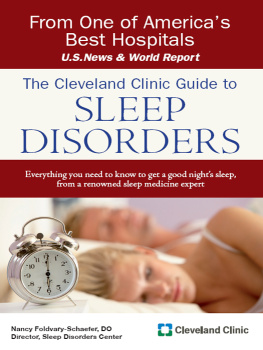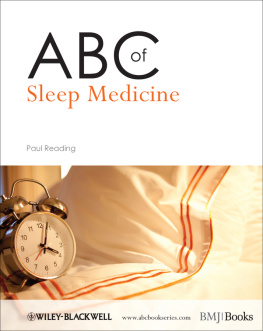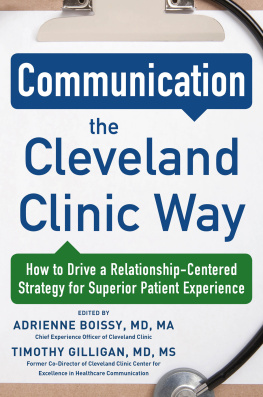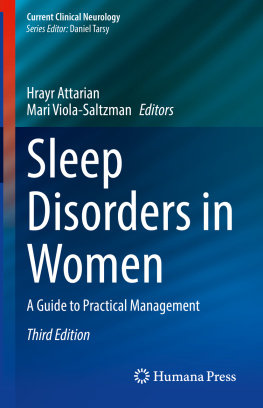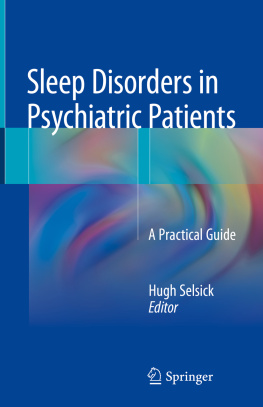Nancy Foldvary-Schaefer - The Cleveland Clinic Guide to Sleep Disorders
Here you can read online Nancy Foldvary-Schaefer - The Cleveland Clinic Guide to Sleep Disorders full text of the book (entire story) in english for free. Download pdf and epub, get meaning, cover and reviews about this ebook. year: 2009, publisher: Kaplan Publishing, genre: Romance novel. Description of the work, (preface) as well as reviews are available. Best literature library LitArk.com created for fans of good reading and offers a wide selection of genres:
Romance novel
Science fiction
Adventure
Detective
Science
History
Home and family
Prose
Art
Politics
Computer
Non-fiction
Religion
Business
Children
Humor
Choose a favorite category and find really read worthwhile books. Enjoy immersion in the world of imagination, feel the emotions of the characters or learn something new for yourself, make an fascinating discovery.
- Book:The Cleveland Clinic Guide to Sleep Disorders
- Author:
- Publisher:Kaplan Publishing
- Genre:
- Year:2009
- Rating:5 / 5
- Favourites:Add to favourites
- Your mark:
- 100
- 1
- 2
- 3
- 4
- 5
The Cleveland Clinic Guide to Sleep Disorders: summary, description and annotation
We offer to read an annotation, description, summary or preface (depends on what the author of the book "The Cleveland Clinic Guide to Sleep Disorders" wrote himself). If you haven't found the necessary information about the book — write in the comments, we will try to find it.
The Cleveland Clinic Guide to Sleep Disorders — read online for free the complete book (whole text) full work
Below is the text of the book, divided by pages. System saving the place of the last page read, allows you to conveniently read the book "The Cleveland Clinic Guide to Sleep Disorders" online for free, without having to search again every time where you left off. Put a bookmark, and you can go to the page where you finished reading at any time.
Font size:
Interval:
Bookmark:
The Cleveland Clinic Guide to
SLEEP
DISORDERS
Nancy Foldvary-Schaefer, MD

To Errol Schaefer,
my husband and best friend
and to
Isabela Schaefer,
our ever-smiling daughter
Contents
Y ou cant escape references to sleep in modern culture. Terminology and slang related to sleep permeate our language: all-nighters, nightcaps, catnaps, night owls, sleeper movies. Our culture is ever curious about the importance of sleep, even while we search for ways to make the most of our waking hours.
Recent research reminds us of the importance of adequate sleep, the consequences of sleep deprivation, and the impact of sleep disorders on the quality of our lives. Sleep loss affects our mental and physical well-being, interpersonal relationships, and performance behind the wheel, at school, and on the job. And sleep disorders contribute to a variety of medical conditions, including high blood pressure, cardiac arrhythmias, diabetes, and obesity, to name a few. A good nights sleep is critical for a healthy, happy life.
But sleep deprivation has evolved into an epidemic of sorts. If youre like me and most Americans, you have experienced the effects of sleep deprivation or know someone with a sleep disorder. The corporate world pressures us to conform to rigorous schedules. We overprogram ourselves, jamming our days with professional, extracurricular, family, and social activities. We teach our children to do the same, encouraging back-to-back after-school activities that book their free time well into the evening hours. Popular culture has responded to our lack of sleep with solutions to keep us awake, among them the coffee-shop revolution and a wide selection of energy drinks. Its no wonder we are running on empty, building up a sleep deficit as we go through our busy days.
Reflecting these trends, sleep medicine has grown into an established medical specialty, and more people than ever before are turning to sleep specialists and sleep disorders centers for answers. Since I began treating patients with sleep disorders nearly 15 years ago, America has witnessed an explosive growth in the number of physicians choosing sleep as a specialty and an equally impressive proliferation of accredited sleep laboratories. Today we know that sleep affects virtually every aspect of life and interrelates with many disciplines in medicine. As one of the bodys basic needs, sleep is responsible for restoring and preserving our health. This book is dedicated to the thousands of men, women, and children with sleep problems whom I have met and treated over the years and who have taught me so much of what I now know about sleep medicine.
If youve picked up this book, you are or someone you love is probably suffering from the effects of inadequate or unrefreshing sleep. Maybe your partner snores horribly, keeping you up for hours if you dont fall asleep first. Or perhaps you lay awake for hours each night for no apparent reason, unable to fall asleep despite a deep feeling of exhaustion (Ive done this myself many nights!). Your child might complain of waking up several times a night, or of daytime tiredness.
In these pages, Ill introduce you to the field of sleep medicine, explain the importance of sleep, and give you a glimpse of what sleep testing is all about. Through case histories of some of my own patients, Ill illustrate several of the most common sleep disorders: Obstructive sleep apnea, narcolepsy, psychophysiological insomnia, delayed sleep phase syndrome, sleep terrors and sleepwalking, restless legs syndrome, and REM sleep behavior disorder. And Ill offer pearls and words of caution about treatments that will help you get the zs you need. Above all, I hope to show you that you are not alone.
A book, however, is not a substitute for seeing a doctor. If you suspect that you or a loved one has a sleep disorder, I hope this volume guides you toward the attention you should receive to treat your condition. Because everyone deserves a good nights sleep.
Sweet dreams.
Nancy Foldvary-Schaefer, D.O.
Director
Cleveland Clinic Sleep Disorders Center
Neurological Institute
Associate Professor of Medicine
Cleveland Clinic Lerner College of Medicine of Case Western Reserve University
www.clevelandclinic.org/sleep
To achieve the impossible dream, try going to sleep.
Joan Klempner
M ost of us who complain of sleep problems are armed with excuses for our lack of zs.
A worrywart restlessly pores over a mental to-do list: How am I going to finish this project tomorrow? What did he mean when he said that in the meeting? Am I spending enough time with my children?
A stubborn professional justifies sleep deficiency as a personality trait: Ive never slept that well anyway. Im lucky to get six hours.
Or theres the anthem of the ambitiousmore coffee, less sleep: Ill sleep when Im dead. Why waste time in bed?
Chronic nonsleepers often attribute their wakefulness to normal behavior for any night person. But when we lose sleep, we risk our health. And just as serious are the cases of people who sleep all night but still drag through the day, exhausted. Job performance drops, they doze off during meetings, and they depend on stimulants to restore their energy so they can spend time with family in the evenings. Sleep disorders affect how we feel both at night and during the day.
Sleep isnt a luxury; it is a necessity. Those hours of lost sleep add up to a greater health deficit than many might realize. We need sleep so we can restore nutrients, replenish the spirit, and refresh the mind. Hidden health hazards accumulate during periods of sleeplessness, and they cant be covered up with concealer or reversed with caffeine.
Sleep ranks in importance with diet and exercise, yet many Americans are sleep-deprived70 million of us, to be exact. The number of people with sleep disorders climbs steadily each year, but we continue to regard sleep as extracurricular and optional.
This attitude is dangerous. And sometimes, the side effects from disrupted sleep are extreme.
Take Jos, for example.
Jos
During my very first week working as a sleep specialist, Jos, 44, hobbled into my office. His leg was broken, but he didnt sustain the injury from sports or anything of the kind. Instead, this father had jumped out of his third-floor bedroom window while sleepwalking. He was escaping a house fire, he told me, still visibly shaken. Fortunately, he didnt save his 3-year-old son, who was sleeping soundly in an adjacent roomthough apparently he had tried to do just that. Instead of grabbing the boy, he had tossed a bedside lamp out the window before taking his own plunge. Jos thought he must have mistaken the lamp for his boy, who normally shared the bed with him and his wife, Mary.
Joss broken leg was a wake-up call to a serious sleep disorder.
After the incident, Joss wife, Mary, decided that the family needed a new sleeping arrangement. Now, she and their son wish Jos a goodnight from the safety of the familys spare bedroom. Once inside, Mary locks the windows and door.
I hate doing this, Mary tells Jos every night.
Terrified of what might happen if he sleepwalks again, Mary has begged Jos to see a doctor.
Four percent of the population sleepwalks, but Joss activity is more severe than most. More common, perhaps, are situations like John and Barbs.
John and Barb
John and Barb have shared a bed for 18 years. He stretches out on the left; she curls up on the right. He unwinds to the droning noise of the 11 oclock news; she retires with a best-seller. John rarely lasts through the first commercial break before dozing off, but Barbs reading light might burn past midnight if shes reading a page-turner. He falls asleep on his back; she prefers her side.
Next pageFont size:
Interval:
Bookmark:
Similar books «The Cleveland Clinic Guide to Sleep Disorders»
Look at similar books to The Cleveland Clinic Guide to Sleep Disorders. We have selected literature similar in name and meaning in the hope of providing readers with more options to find new, interesting, not yet read works.
Discussion, reviews of the book The Cleveland Clinic Guide to Sleep Disorders and just readers' own opinions. Leave your comments, write what you think about the work, its meaning or the main characters. Specify what exactly you liked and what you didn't like, and why you think so.

